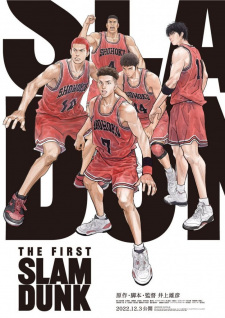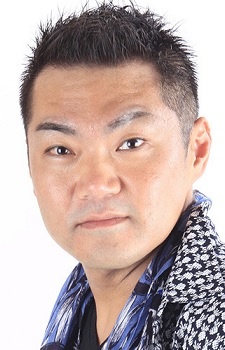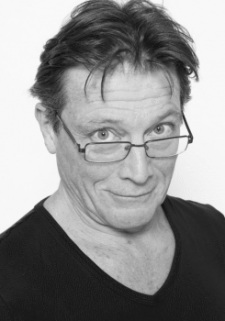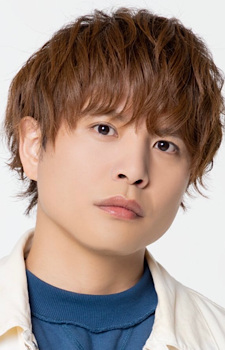
The First Slam Dunk
Summary: Shohoku's "speedster" and point guard, Ryouta Miyagi, always plays with brains and lightning speed, running circles around his opponents while feigning composure. Born and raised in Okinawa, Ryouta had a brother who was three years older. Following in the footsteps of his older brother, who was a famous local player from a young age, Ryouta also became addicted to basketball.
In his second year of high school, Ryouta plays with the Shohoku High School basketball team along with Sakuragi, Rukawa, Akagi, and Mitsui as they take the stage at the Inter-High School National Championship. And now, they are on the brink of challenging the reigning champions, Sannoh Kogyo High School.
(Source: GKIDS, edited)
Description
Shohoku's "speedster" and point guard, Ryouta Miyagi, always plays with brains and lightning speed, running circles around his opponents while feigning composure. Born and raised in Okinawa, Ryouta had a brother who was three years older. Following in the footsteps of his older brother, who was a famous local player from a young age, Ryouta also became addicted to basketball.
In his second year of high school, Ryouta plays with the Shohoku High School basketball team along with Sakuragi, Rukawa, Akagi, and Mitsui as they take the stage at the Inter-High School National Championship. And now, they are on the brink of challenging the reigning champions, Sannoh Kogyo High School.
(Source: GKIDS, edited)
The First Slam Dunk Trailers
The First Slam Dunk Pictures
The First Slam Dunk Review
The First Slam Dunk — Shohoku's "speedster" and point guard, Ryouta Miyagi, always plays with brains and lightning speed, running circles around his opponents while feigning composure. This overview is intentionally spoiler-free and focuses on tone and intent rather than plot specifics.
Thematically, It sits firmly within Award Winning, Sports conventions as a Movie work and has garnered attention (MAL score: 8.72). This work explores character dynamics, tonal shifts, and the interplay between narrative ambition and execution. The story's pacing and tonal choices are crafted to complement the central ideas, often emphasizing atmosphere and emotional truth over explicit exposition. The show's ability to evoke a consistent mood — whether melancholic, exuberant, or contemplative — is a recurring strength, and the scenes are constructed so viewers can infer stakes without needing explicit spoilers.
Characterization is a core pillar here. Protagonists and supporting figures are written with distinct motivations and narrative roles; even when archetypal, the series invests in small behavioral details that make choices feel earned. Character arcs are handled with an eye for gradualism: development often arrives through incremental beats rather than abrupt, expository shifts. The interactions between characters create texture, and relationships are used to illuminate both personal flaws and larger thematic concerns.
On the visual front, production values play a significant role. The animation quality varies by sequence but frequently showcases thoughtful direction and composition. Background art, framing, and color palettes are used deliberately to support tone — quieter scenes favor muted palettes while action or heightened emotional beats employ brighter, more kinetic visuals. Direction choices, such as camera movement and shot selection, often elevate scenes beyond their raw script, creating moments that linger in the viewer's mind.
The soundscape — score, incidental music, and sound design — complements the visual language. Music cues are placed to maximize emotional resonance without manipulating the audience with melodrama; this restraint often leads to more authentic emotional payoff. Sound design punctuates key moments, and when the series leans on silence, those quieter moments are given weight by measured audio choices.
Pacing and structure are handled with craft. Episodes are arranged to build tension and release methodically, and the narrative rarely rushes through important emotional beats. That said, the deliberate pacing may feel slow to viewers who prefer faster plot turnover; the reward is greater nuance and an accumulation of meaning across the series. Accessibility is generally good — one can appreciate surface-level pleasures, while repeat or attentive viewing reveals additional layers.
No title is without flaws. Occasional unevenness in subplots or variable animation across episodes can be distracting. Some tonal shifts might feel abrupt if you expect uniformity; others will argue that those shifts are purposeful. These are worth noting, but they seldom undercut the larger achievements of the work.
In sum, The First Slam Dunk offers a rich experience for viewers who value character-driven storytelling, considered visual design, and a soundtrack that supports rather than overwhelms. For fans of Award Winning, Sports, this is an especially rewarding watch. It's recommended for those who appreciate layered narratives and artistry in animation, and best approached with patience and attention to nuance.
Characters & Voice Actors

Akagi, Takenori
Main

Akagi, Takenori
Main

Akagi, Takenori
Main

Akagi, Takenori
Main

Akagi, Takenori
Main

Akagi, Takenori
Main

Mitsui, Hisashi
Main

Mitsui, Hisashi
Main

Mitsui, Hisashi
Main

Mitsui, Hisashi
Main

Mitsui, Hisashi
Main

Mitsui, Hisashi
Main

Miyagi, Ryouta
Main

Miyagi, Ryouta
Main

Miyagi, Ryouta
Main

Miyagi, Ryouta
Main

Miyagi, Ryouta
Main

Miyagi, Ryouta
Main

Miyagi, Ryouta
Main

Miyagi, Ryouta
Main
Staff

Inoue, Takehiko
Director, Script, Original Creator

Kasamatsu, Kouji
Sound Director

Kamatani, Haruka
Episode Director

Kitada, Katsuhiko
Episode Director, Key Animation

Miyahara, Naoki
Episode Director

Suganuma, Fumihiko
Episode Director

10-FEET
Theme Song Performance

TAKUMA
Theme Song Lyrics, Theme Song Composition

The Birthday
Theme Song Performance

Arruti, Lourdes
ADR Director

Arto, Ken
Key Animation

Ashiya, Kouhei
Key Animation, Animation Director

Ban, Yukiko
Animation Director, Character Design

Correa, Alexandra
ADR Director

Ebara, Yasuyuki
Animation Director, Character Design

Furushou, Shiori
Color Design

Hasegawa, Masaya
2nd Key Animation

Hirota, Noriyuki
2nd Key Animation

Honda, Takatoshi
Key Animation, Animation Director

Hwang, Mi-ye
Animation Check